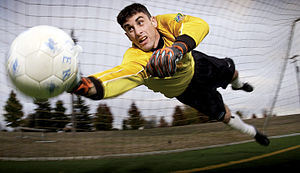The physics of a goal keeper
A goalkeeper is constantly analyzing the various
vectors on the field. He considers the possible angles that
the person with the ball might have for a shot, while also
keeping track of who they might pass to, and if they have an
angle for a shot. He also has to anticipate the Magnus
effect on the ball so that he can position accordingly to
defend. His goalie gloves were designed to minimize the
force imparted on the goalie's hand. Soft foam maximizes
impulse by absorbing the momentum of the ball for a little
longer, allowing the goal keeper to grab a hold of more of
the shots. When attempting to catch the ball, the goalie's
hands must be positioned so that the friction is enough to
stop the ball from slipping through his hands, without his
hands being so open as to allow the ball to deflect rather
than being caught. A goal keeper also keeps his weight
forward, so that he can jump forward while deflecting the
ball. Because of the conservation of momentum, this causes
the ball to deflect as far away from the goal as possible. A
goalkeeper may also try to redirect the ball by hitting it
at an angle. This changes the ball's motion vector. Even if
the ball is still moving away from the kicker, it is
deflected over the goal rather than into it. The goalie's
punch is often less inclined about changing the ball's
horizontal speed, and more focused on increasing it's motion
in the vertical direction.
